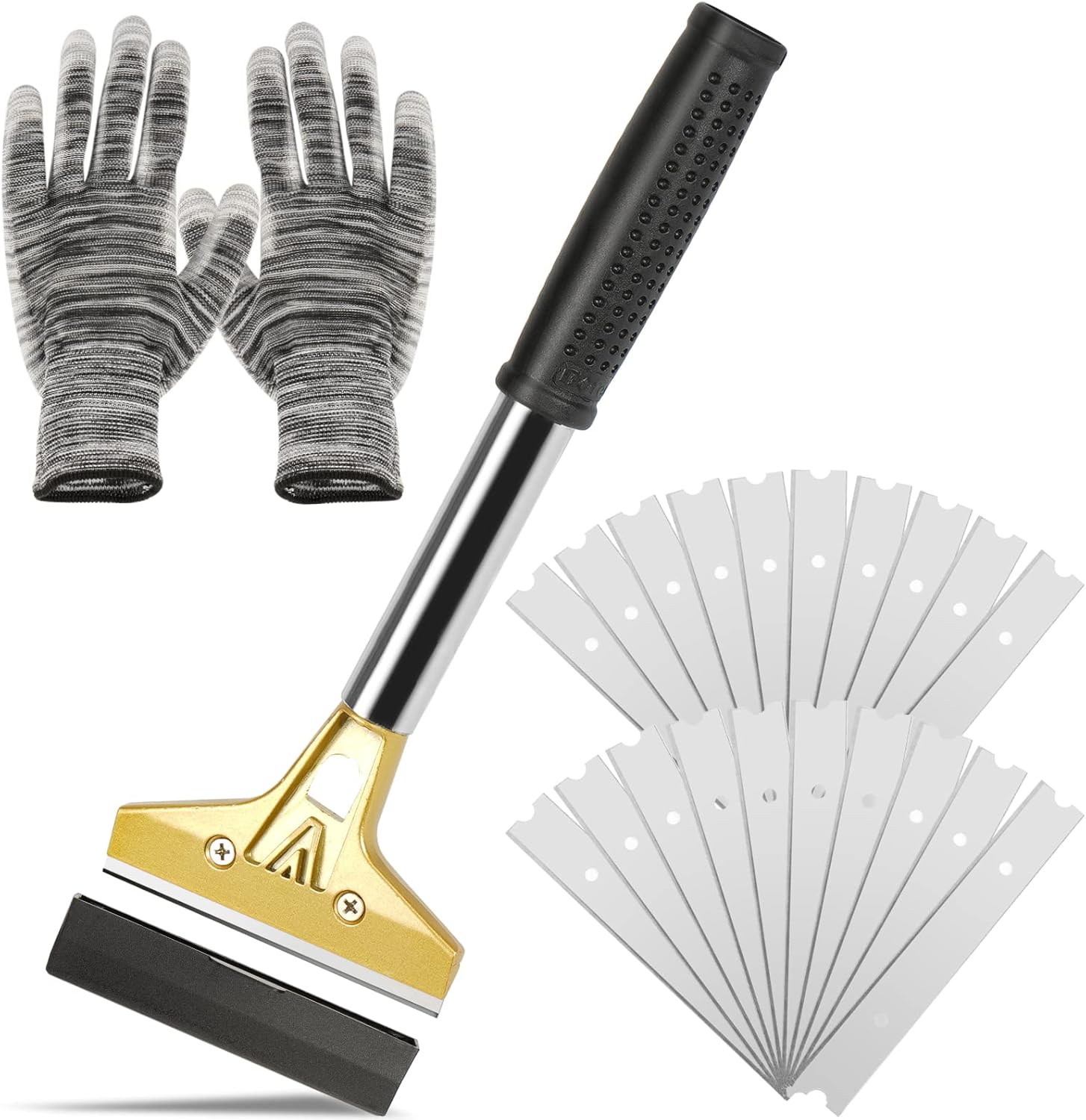When you’re tackling a paint removal project, whether it’s refreshing your house’s exterior, stripping down old furniture, or preparing a surface for a fresh coat of paint, having the right tools can make all the difference.
But with so many types of scrapers available, how do you know which one is the best fit for your needs?
Whether you’re a DIY enthusiast or a professional looking to streamline your work, choosing the right scraper can make your paint-removal task a lot easier and more efficient.
Are you tired of struggling with stubborn paint that just won’t come off? Maybe you’ve been using the wrong tool for the job, or perhaps you just haven’t found the perfect scraper that makes the job less of a hassle. This guide is here to help you solve that problem.
In this post, we’ll dive into everything you need to know about selecting the best scraper for removing paint.
We’ll break down different types of scrapers, how to use them effectively, and what to keep in mind to avoid making common mistakes.
We’ll even touch on some common misconceptions to help you choose the right tool for the job and ensure that your paint-removal project goes smoothly.
What Is a Paint Scraper, and Why Do You Need One?
A paint scraper is a simple yet highly effective tool used to remove old paint, varnish, or other coatings from surfaces.
Whether you’re working on a wooden, metal, or concrete surface, a scraper helps you get rid of old, chipped paint quickly and efficiently.
This tool is essential for a variety of DIY projects, home renovations, and even professional jobs like restoring antique furniture or preparing surfaces for a new coat of paint.
But why is it so important to choose the right one?
If you’ve ever worked on a paint removal project, you know that using the wrong scraper can make your task a lot more difficult.
Some scrapers are designed for specific types of surfaces or paint removal techniques, and using the wrong one can cause unnecessary damage to the underlying material or prolong the job unnecessarily.
| Product Image | Product Name | Features | Price |
|---|---|---|---|
 |
Bates- Paint Scraper | Multi-Function Utility Durable blade resists corrosion and delivers reliable performance Comfortable Wood Grip Compact & Convenient |
Check Price |
 |
MulWark Razor Blade Scraper | Includes a compact stainless steel scraper for tight spaces and an extendable-handle scraper for hard-to-reach areas Safe Blade Packaging Fits easily in pockets or toolboxes Heavy-Duty Build Quality |
Check Price |
 |
Razor Blade Scrape with 15pcs Extra Blades | Complete Scraper Kit Safe & Non-Slip Design Press the gray button and slide forward to reveal the blade Efficient & Portable |
Check Price |
 |
DEWALT 9-in-1 Painter’s Too | High-Carbon Steel Blade 9-in-1 Versatile Head Impact-Resistant Nylon Handle Ideal for professional finishing tasks |
Check Price |
 |
Hyde Contour Scraper with 6 Changeable Blades | Multi-Surface Scraping Power 6 Interchangeable Blades with 12 Edges Designed for long hours of use with minimal hand fatigue Ideal for serious renovation and refinishing tasks |
Check Price |
 |
Razor Blade Scraper | Complete Scraper Set Rock-Hard Blade Stability Sharp & Efficient Cleaning Built from high-strength aluminum alloy and engineering-grade plastic |
Check Price |
 |
XW Heavy Duty Carbide Scraper | Soft-Grip Ergonomic Handle Heavy-Pressure Pull-Knob Quick Blade Replacement Ultra-Durable Carbide Blade Slim Head for Tight Spaces |
Check Price |
Types of Paint Scrapers: Choosing the Right One for Your Project
Not all paint scrapers are created equal. There are several types, each designed for a specific use. In this section, we’ll break down the different categories of scrapers and help you figure out which one works best for your needs.
1. Standard Handheld Scrapers
These are your traditional manual scrapers, typically made from a metal or plastic blade attached to a sturdy handle. Handheld scrapers come in various shapes and sizes, making them versatile tools for paint removal.
They’re great for smaller areas, tight corners, or detailed surfaces like windowsills, door frames, and baseboards.
- Pros: Affordable, lightweight, easy to control, suitable for small projects.
- Cons: Can be tiring for larger areas, less efficient for heavy-duty work.
2. Scraper with Interchangeable Blades
These scrapers come with a handle and a selection of interchangeable blades, allowing you to switch between different blade types for various surfaces or paint thicknesses. You can choose from curved blades, flat blades, or angled blades depending on the specifics of the job.
- Pros: Versatile, customizable, long-lasting.
- Cons: Higher initial cost than standard scrapers.
3. Electric Scrapers and Heat Guns
When you’re working on large areas or dealing with layers of thick paint, manual scrapers might not cut it.
Electric scrapers and heat guns are ideal for removing stubborn, multiple layers of paint without the need for excessive elbow grease. Heat guns work by softening the paint, making it easier to peel off with a scraper.
- Pros: Fast, reduces physical strain, highly efficient for large projects.
- Cons: Can be expensive, requires a power source, may cause damage if not used carefully.
4. Razor Blade Scrapers
A razor blade scraper is a small, handheld scraper with a thin blade that’s ideal for detailed work on smaller areas. It’s especially useful for removing paint from glass, mirrors, or smooth metal surfaces.
- Pros: Great for fine detail work, very sharp, inexpensive.
- Cons: Not ideal for larger areas, requires caution to avoid injury.
5. Putty Knife Scrapers
Putty knives are flexible, broad blades that are commonly used for paint removal, particularly on delicate surfaces like drywall. These are also great for spreading fillers or smoothing putty, so they’re multi-purpose tools.
- Pros: Flexible, versatile, easy to find.
- Cons: Not the best for scraping thick layers of paint.
How to Use Your Paint Scraper: Step-by-Step Instructions
Once you’ve chosen the right scraper for your project, it’s time to put it to use! Here’s a step-by-step guide to ensure you’re using your paint scraper the right way:
Step 1: Prepare the Surface
Before you start scraping, make sure the surface you’re working on is clean and free from dust or debris. This will prevent dirt from scratching or damaging the surface as you scrape.
- If you’re removing paint from wood, use a mild detergent to clean the area and remove any residue.
- For metal surfaces, you may need to use a wire brush or sandpaper to remove any rust or dirt buildup before scraping.
Step 2: Test a Small Area First
Always start with a small, inconspicuous area to test the scraper. This will allow you to make sure that you’re using the tool correctly and not causing any unintended damage to the surface.
Step 3: Apply the Right Pressure
When you begin scraping, apply moderate pressure on the scraper. You want to remove the paint without gouging or damaging the underlying material. If you’re using a manual scraper, work slowly and steadily, keeping the blade at a low angle.
- If you’re using a heat gun or electric scraper, make sure to keep the tool moving to avoid overheating the surface.
Step 4: Work in Small Sections
Don’t try to remove all the paint at once. Instead, work in small sections to ensure you’re consistently removing the paint and not leaving any behind. It’s much easier to control the scraper this way and will prevent excessive buildup.
Step 5: Dispose of Paint Properly
Once you’ve removed the paint, dispose of it responsibly. Paint scrapings can sometimes contain harmful chemicals, so check local regulations for proper disposal methods. Avoid simply throwing them in the trash without ensuring they are properly sealed.
Common Mistakes to Avoid When Using a Paint Scraper
Now that you know how to use a paint scraper, let’s look at some common mistakes people make when using these tools and how to avoid them.
- Using the Wrong Scraper for the Job
If you use a scraper that’s too large for a delicate surface, you risk damaging the material. Likewise, using a small scraper on a big project can slow you down. Always make sure you’re using the right tool for the job.
- Not Preparing the Surface Properly
If you don’t clean the surface before scraping, you may end up scratching it. Dirt and grime can cause more damage than you think, so take the time to prep the surface first.
- Overusing Force
Applying too much pressure on the scraper can damage the surface, especially when working on wood or drywall. It’s better to apply steady, consistent pressure rather than forcing the scraper to do all the work.
- Not Wearing Protective Gear
Although scraping may seem like a harmless task, it’s always a good idea to wear gloves and goggles for protection, especially when working with harsh chemicals or using power tools.
- The right scraper can make all the difference when removing paint, ensuring a smooth and efficient process.
- Choose the best scraper for your project, considering factors like surface type and paint thickness.
- Always follow the proper technique and safety precautions to avoid damaging surfaces or injuring yourself.
- If you’re dealing with large areas or multiple layers of paint, consider investing in an electric scraper or heat gun.
Conclusion
In conclusion, selecting the best scraper for removing paint depends on a number of factors, from the size of the area to the type of paint you’re working with. Whether you’re a DIY enthusiast or a professional, it’s essential to have the right tool to make the job easier and more efficient.
I hope this guide has helped you understand the different types of paint scrapers and how to choose the right one for your needs.
If you have any questions or want to share your experiences with paint removal, feel free to leave a comment below!
Don’t forget to share this guide with your friends or on social media to help others choose the right scraper for their paint-removal projects!


